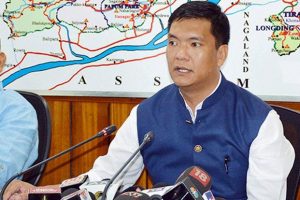
Apang joining Opposition throws Arunachal elections wide open

For those growing up in the 1980s and 1990s of Arunachal Pradesh, there was one question that no one would get wrong in any GK test — who is the chief minister of the state? Once a school teacher anchoring a quiz competition found himself asking, “Who is the Gegong Apang of Arunachal Pradesh?”
That was the Apang era, when one man remained the chief minister for 19 continuous years, from 1980-1999. Today, the politics of the state is dominated by a growing crop of suave, Delhi University-educated politicians, even as Apang tries hard to stay relevant. The state, which goes to Assembly polls and Lok Sabha elections simultaneously on April 11, will see BJP’s Pema Khandu seeking a re-election. For those who were stumped by the BJP’s march into the Northeast with the Assam election in 2016, they should note that it was Arunachal that gave the saffron party its first government in the region 16 years ago.
After heading a Congress government for 19 years since the 1980s, Apang formed a regional outfit, Arunachal Congress, to dislodge his successor Mukut Mithi’s government in 2003. Apang became the chief minister again, this time of a coalition government that merged with the BJP.
Start of mergers and rebellions
In engineering the 2003 coup, Apang was just returning Mithi a favour. A former forest minister in Apang’s government, Mithi had led a revolt within the government in 1999 to become the state’s fourth CM.
After removing Mithi, Apang switched back to the Congress within 44 days. This was after the BJP-led NDA lost the 2004 Lok Sabha elections. With the Congress coming back to power at the centre, the party won the state election that was held in October that year. More than three years later, there was another rebellion with the Congress. This time the rebel MLAs were led by Dorjee Khandu, father of incumbent CM Pema Khandu. These mechanisations and party switchovers in Arunachal Pradesh somehow never caught pan-India attention until 2016.
The 2016 coup
The BJP, after a resounding victory in the 2014 general election, was looking to spread its footsteps in the region. In early 2016, Kaliko Pul, a rebel Congress minister, replaced Nabam Tuki to become the CM with a new party — the People’s Party of Arunachal (PPA) — with BJP support. The BJP had extended the support of its 11 MLAs to help Pul get majority to form a PPA government. Later, 19 other Congress MLAs, including Pema Khandu, joined the PPA to be a part of the Pul government.

Meanwhile, Tuki, who went to the Supreme Court, was reinstated as the CM. But he still had to prove his government’s majority in the floor of the 60-member House. After many permutations and combinations, including backdoor channels for talks with the rebel MLAs, the Congress reached a compromise formula. It was decided Tuki would make way for Khandu.
By December 2016, Khandu along with six other MLAs were suspended by the PPA for “attempts” to merge the regional outfit with the BJP. Khandu managed to prove majority in the House with 33 of the PPA’s 43 MLAs joining the BJP, giving the saffron party its second government in Arunachal Pradesh.
How things stand now
At the height of protests across the region against the controversial Citizenship Bill, Apang, who rejoined the BJP in 2014, quit the party and, this time, walked into the Janata Dal (Secular). In January, he was seen at the Trinamool Congress’ mega-Opposition rally in Kolkata. Following the recent unrest over granting permanent resident certificate (PRC) to six non-Arunachal Schedule Tribes living in the state, Apang and his allies, including Congress and PPA heavyweights, have upped the ante against BJP’s “misrule”.
The Opposition has kept the heat on the BJP in the past two months over issues such as the Citizenship Bill and the PRC, occasionally taking to social media against the lack of development and basic amenities because of corruption in the government. Charges of corruption against the government, however, are less likely to stick, especially coming from a former CM who was arrested on alleged corruption charges back in 2010. Chief Minister Khandu, too, is often heard talking about greater transparency, development and inclusion in his rule, which the state never witnessed during decades of Congress regime.
But it is ultimately the voters who will decide if Arunachal will subscribe to Khandu’s claim of transparency or fall back on the old warhorse. As of now, we know for sure Apang joining the Opposition ranks has thrown the Arunachal elections wide open.


